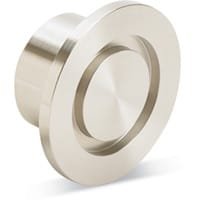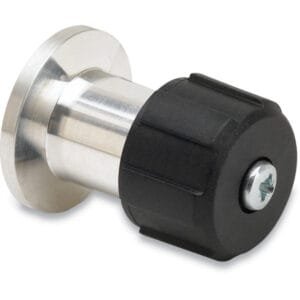KF (QF) HV Blank Stubs (Aluminum 6061-T6): Lightweight Port Sealing for General High-Vacuum Applications
KF (QF) HV Blank Stubs (Aluminum 6061-T6) are high-performance sealing components designed for capping unused ports in high-vacuum (HV) systems. These stubs combine the standardized KF (Klein Flansche) flange design with the lightweight durability of Aluminum 6061-T6, offering vacuum engineers a dependable, cost-effective solution for general-purpose and modular vacuum setups.
Each KF (QF) HV Blank Stub (Aluminum 6061-T6) features a precision-machined KF flange on one end and a closed cylindrical stub on the other, effectively acting as a solid cap that integrates directly into standard KF vacuum assemblies. The design enables system isolation, port protection, and flexible reconfiguration during equipment staging, maintenance, or future upgrades.
The aluminum construction makes these blank stubs exceptionally well-suited for environments where reduced mass and material versatility are essential. Aluminum 6061-T6 offers excellent machinability, corrosion resistance in dry conditions, and good thermal conductivity—qualities that make these components ideal for use in research laboratories, educational setups, prototype vacuum systems, and lightweight instrument builds.
KF (QF) HV Blank Stubs (Aluminum 6061-T6) maintain a secure vacuum seal using a standard elastomeric o-ring housed in a centering ring. When mated with another KF flange and secured using a circumferential clamp—whether with a wing-nut, thumbscrew, bolt, or over-center lever—the connection achieves a reliable seal rated for pressures down to 10⁻⁸ Torr. The o-ring also defines the system’s operating temperature range, typically between 0 °C and 120–180 °C, depending on the o-ring material selected.
These blank stubs are most frequently used in systems where flexibility and frequent changes are part of the process—such as vacuum R&D platforms, modular diagnostic chambers, and test benches. Their KF compatibility allows quick installation and removal without tools, reducing system downtime and supporting cleanroom best practices.
TFM offers KF (QF) HV Blank Stubs (Aluminum 6061-T6) in all standard KF sizes, including KF16, KF25, KF40, and KF50, to accommodate a wide range of system configurations. Each component is manufactured with tight dimensional tolerances and finished to vacuum-grade standards to ensure consistency and performance. Custom options such as vent holes, extended stub lengths, or laser-marked identification are available upon request.
In summary, KF (QF) HV Blank Stubs (Aluminum 6061-T6) are the lightweight, cost-efficient solution for capping unused KF ports in general high-vacuum applications. Their blend of performance, flexibility, and standardization makes them an essential component in the toolkit of any vacuum system designer or technician.
Ordering Table
Accessories Table
| Description | For | Per Package | Part Number |
| Cast Clamps (Aluminum) | KF10, KF16 Flanges | 1 | QF16-075-C |
| Cast Clamps (Aluminum) | KF25 Flanges | 1 | QF25-100-C |
| Cast Clamps (Aluminum) | KF40 Flanges | 1 | QF40-150-C |
| Cast Clamps (Aluminum) | KF50 Flanges | 1 | QF50-200-C |
| Lever Clamps (Aluminum) | KF10, KF16 Flanges | 1 | QF16-075-CHA |
| Lever Clamps (Aluminum) | KF25 Flanges | 1 | QF25-100-CHA |
| Lever Clamps (Aluminum) | KF40 Flanges | 1 | QF40-150-CHA |
| Centering Ring (Aluminum with Fluorocarbon O-Ring) | KF10 Flanges | 1 | QF10-050-ARV |
| Centering Ring (Aluminum with Fluorocarbon O-Ring) | KF16 Flanges | 1 | QF16-075-ARV |
| Centering Ring (Aluminum with Fluorocarbon O-Ring) | KF25 Flanges | 1 | QF25-100-ARV |
| Centering Ring (Aluminum with Fluorocarbon O-Ring) | KF40 Flanges | 1 | QF40-150-ARV |
| Centering Ring (Aluminum with Fluorocarbon O-Ring) | KF50 Flanges | 1 | QF50-200-ARV |





Reviews
There are no reviews yet.